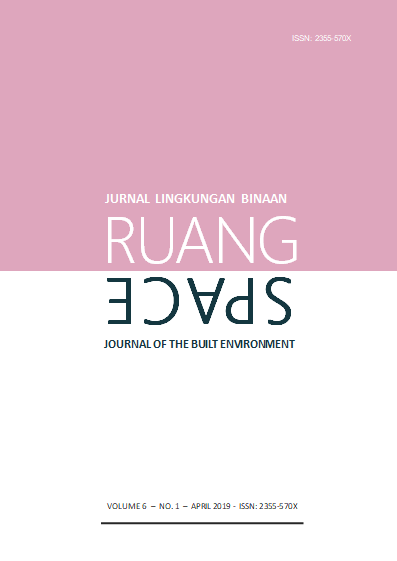Eksistensi Lahan Terlantar di Kawasan Renon Denpasar
Abstract
The development of Denpasar City that stands out will run well if it is on land that is in accordance with the function of land use and runs continuously.The phenomenon that occurs in the Renon Area of Denpasar is that there are dozens of land that are not functioning or utilized to the maximum so that the land is vacant. This study identified the characteristics of vacant land and the factors that caused the vacant land in the Renon Area of Denpasar. The existence of vacant land can have a negative impact on the potential decline in land use, as well as the implications for the image of the city in the Renon Area of Denpasar. Typological theory, characteristics of vacant land and land use are used in the theoretical study approach. This study used a qualitative method, as a source of data carried out observation, direct documentation and data from interviews with informants of vacant landowners and surrounding communities. The results showed that the typology of vacant land in the Renon Area was land with natural vegetation and was not maintained, land with vacant buildings, land with building debris, and land with semi-permanent buildings that were used for temporary activities. Factors causing the vacant land include: socio-economic factors, factors in physical conditions / location, government policy / administration factors. The results of the research in the form of identifying typologies and causes of vacant land can have significant implications for the development of government policies, and for urban planners and designers in seeking the best benefits in the use of vacant land for the benefit of all parties.
Keywords: function, vacant land, land utilization, Renon Area
Abstrak
Perkembangan pembangunan Kota Denpasar yang menonjol akan berjalan dengan baik apabila berada diatas lahan yang sesuai dengan fungsi dari peruntukan lahan dan berjalan secara berkesinambungan. Fenomena yang terjadi di Kawasan Renon Denpasar terdapat puluhan lahan yang tidak difungsikan ataupun dimanfaatkan dengan maksimal sehingga terjadinya lahan terlantar. Penelitian ini mengidentifikasikan karakteristik lahan terlantar dan faktor-faktor penyebab terjadinya lahan terlantar di Kawasan Renon Denpasar. Eksistensi lahan terlantar dapat berdampak buruk pada turunnya potensi pemanfaatan lahan, maupun implikasi terhadap citra kota di Kawasan Renon Denpasar. Teori tipologi, karakteristik lahan terlantar dan penggunaan lahan digunakan dalam pendekatan kajian teori. Penelitian ini menggunakan metode kualitatif, sebagai sumber data dilakukan observasi, dokumentasi langsung dan data hasil wawancara informan pemilik lahan terlantar serta masyarakat sekitar. Hasil penelitian menunjukkan tipologi lahan terlantar pada Kawasan Renon adalah lahan dengan tumbuh-tumbuhan alami dan tidak terawat, lahan dengan bangunan yang terbengkalai, lahan dengan puing-puing bangunan, dan lahan dengan bangunan semi permanen yang difungsikan untuk kegiatan temporer.Faktor penyebab terjadinya lahan terlantar diantaranya: faktor sosial-ekonomi,faktor kondisi fisik / lokasi,faktor kebijakan / administrasi pemerintah. Hasil penelitian yang berupa pengidentifikasian tipologi dan penyebab dari lahan terlantar ini dapat memberikan implikasi yang signifikan terhadap pengembangan kebijakkan pemerintah, dan bagi perencana serta perancang kota dalam mencari manfaat terbaik dalam pemanfaatan lahan terlantar demi kepentingan semua pihak.
Kata kunci : fungsi, lahan terlantar, pemanfaatan lahan, Kawasan Renon
Downloads
The copyright of the received article shall be assigned to the journal as the publisher of the journal. The intended copyright includes the right to publish the article in various forms (including reprints). The journal maintains the publishing rights to the published articles.



